Bromelieads are delightful indoor plants. Their bright colors and interesting foliage will add a little “pizzazz” to any room. Because bromeliads are native to tropical areas, our homes tend to not be ideal environments for these plants. Fortunately, there are some species that will still thrive in most homes as long as long as they are watered correctly and exposed to enough sunlight. Some of these species are discussed below.
1. Vriesea splendens (Flaming Sword)

Vriesea splendens, which is commonly known as Flaming Sword or Painted Feather, is a popular houseplant commonly sold in gardening centers and big box stores. It is native to Trinidad, eastern Venezuela, and Guianas. In the wild, it can adapt to a variety of environments and live as an epiphytic, saxicole (rock-dwelling), or terrestrial plant. Because it can adapt so well to different climates in the wild, it is no surprise that it does well in greenhouses and indoors.
Like other bromeliads, these plants will flower when they mature. The flower will last for several months before the mother plant begins to die and “pups” start to grow from the mother plant.
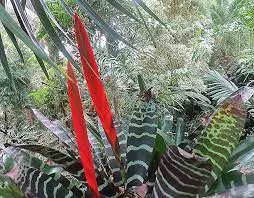
This plant will do well in bright, indirect light. However, it should not be kept in an area that receives hot afternoon sunlight. Brown leaf patches will develop on the leaves if this plant is exposed to sunlight that is too intense.
2. Billbergia nutans (Friendship Plant)

Billbergia nutans, also known as Queen’s Tears or Friendship Plant, is a vigorously growing bromeliad that blooms clumps of tubular rosettes. This plant is commonly referred to as Friendship Plant because it is easy to propagate and is often passed among plant friends.
Most of these plants will bloom in late March or early April. The flowers will last for 6 to 8 weeks. However, this type of plant will not bloom if it is not receiving enough sunlight.
If you are having a difficult time getting your Friendship Plant to bloom, try placing a few apple cores around the plant. Then place a plastic bag around the plant for a week. The ethylene gas produced by the apples will encourage budding. Air plant growers use similar techniques (often with more powerful chemicals) to encourage blooming.
Friendship Plant is native to Brazil, Paraguay, Uruguay, and Argentina. In the wild, this type of plant grows on the branches of low-growing trees in the rainforest. They will also grow on the forest floor.
Put Friendship Plant in a pot of loose bark mix or orchid mix. Although Friendship Plant grows epiphytically in nature, this plant will actually grow a root system if planted in well-draining soil. This root system results in a hardier plant.
3. Tillandsia harrisii
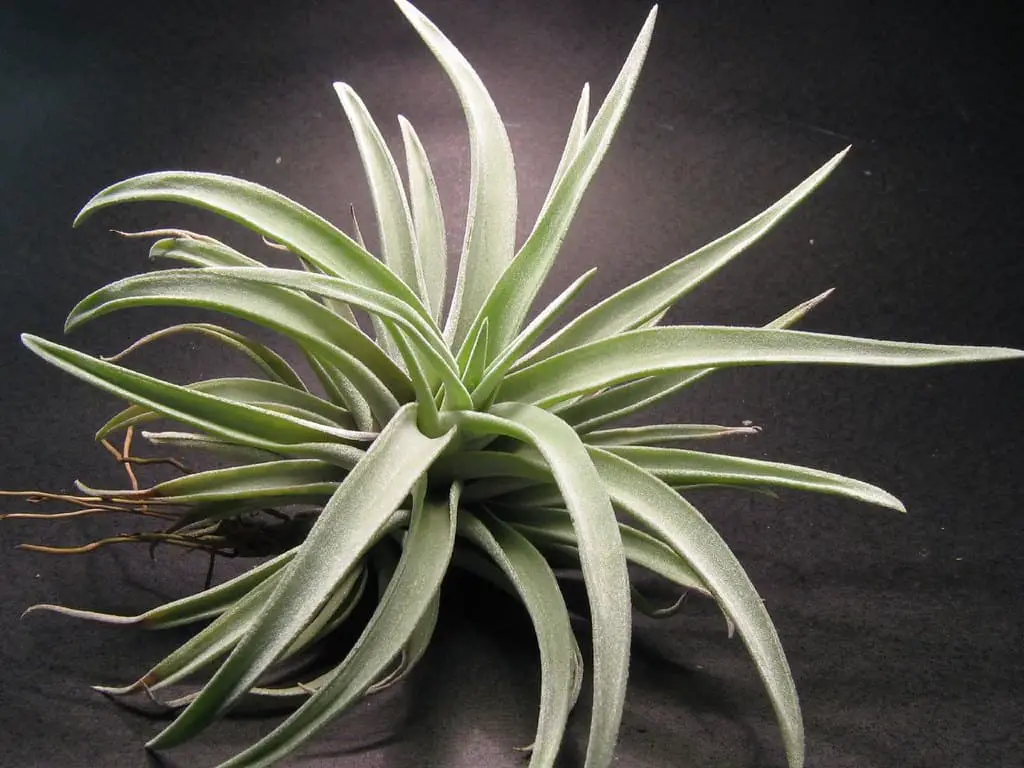
Tillandsia harrisii is a type of air plant with fuzzy, silver leaves. The silvery appearance can be attributed to an abundance of trichomes, which are small hairs that help the plant absorb water.
Harrisii is a good variety of air plant for first-time air plant owners because it is very forgiving of mistakes. These plants will also do well in a variety of locations within your home as long as it is getting some light throughout the day.
Harrisii plants are native to Guatemala. In the wild, they are found at altitudes between 0 to 500 meters above sea level. This species of air plant was named for Bill Harris who was a Canadian business consultant who started the first tillandsia exporting business in Guatemala during the 1970s. Tragically, Bill Harris was murdered in Guatemala in February 1986.
The harrisii plant will eventually bloom beautiful pink and purple flowers. The bloom will typically last between two and three weeks.
4. Aechmea fasciata (Urn Plant)
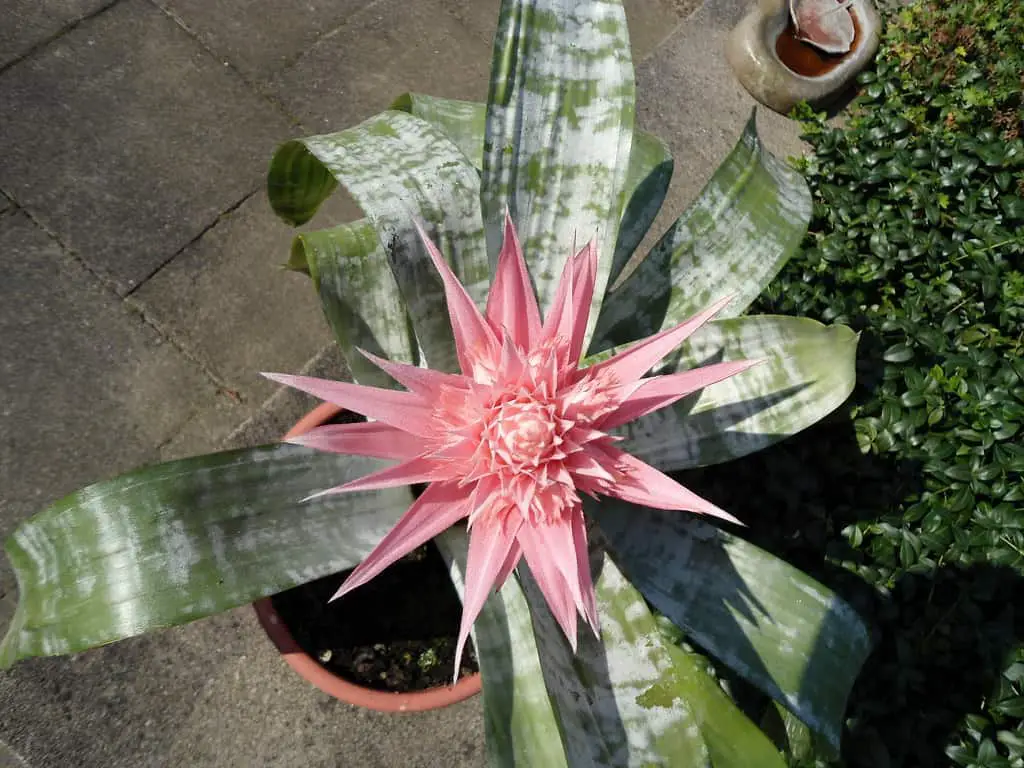
Aechmea fasciata, which is commonly referred to as Urn Plant or Silver Vase Plant, is another bromeliad that grows well indoors. Personally, this is one of my favorite bromeliads. I love the light green leaves and the flower.
It is important to ensure that these plants receive enough sunlight. Otherwise, they can lose the pattering on their leaves. Placing these plants next to an east-facing or west-facing window will work well.
These plants get the name “Urn Plant” or “Silver Vase Plant” from the reservoir in the middle of the plant. In the wild, water collects in this reservoir. Fill the reservoir about 1/4 to 1/3 of the way full when growing these plants indoors. To avoid rot or bacteria issues, rinse the reservoir out with fresh water every couple of weeks.
The spines on the outer edges of the leaves can cause skin irritation. For this reason, Urn Plant is listed as having a skin-irritating substance on the United States Food and Drug Administration’s (FDA’s) Poisonous Plant Database.
5. Tillandsia ionantha
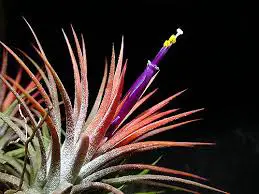
Tillandsia ionantha is the most widely available air plant. You can find these plants in big box stores, gardening centers, and even supermarkets. This plant is sometimes referred to as the Blushing Bride or Sky Plant.
Tillandsia ionantha is a relatively small plant that makes a fun addition to nick nacks and smaller pots. On average, the ionanthas sold at more gardening centers and grocery stores will be between 1 and 3 inches.
Like many of the other plants on this list, this air plant is native to the tropical forests of Mexico, Costa Rica, Nicaragua, El Salvador, Guatemala, and Honduras. You can also find them growing in the wild in certain parts of Florida.
One of the most exciting parts of owning an ionantha plant is seeing it bloom. These plants produce little purple flowers. You will know when an ionantha is about to bloom because it will start to “blush” or turn red.
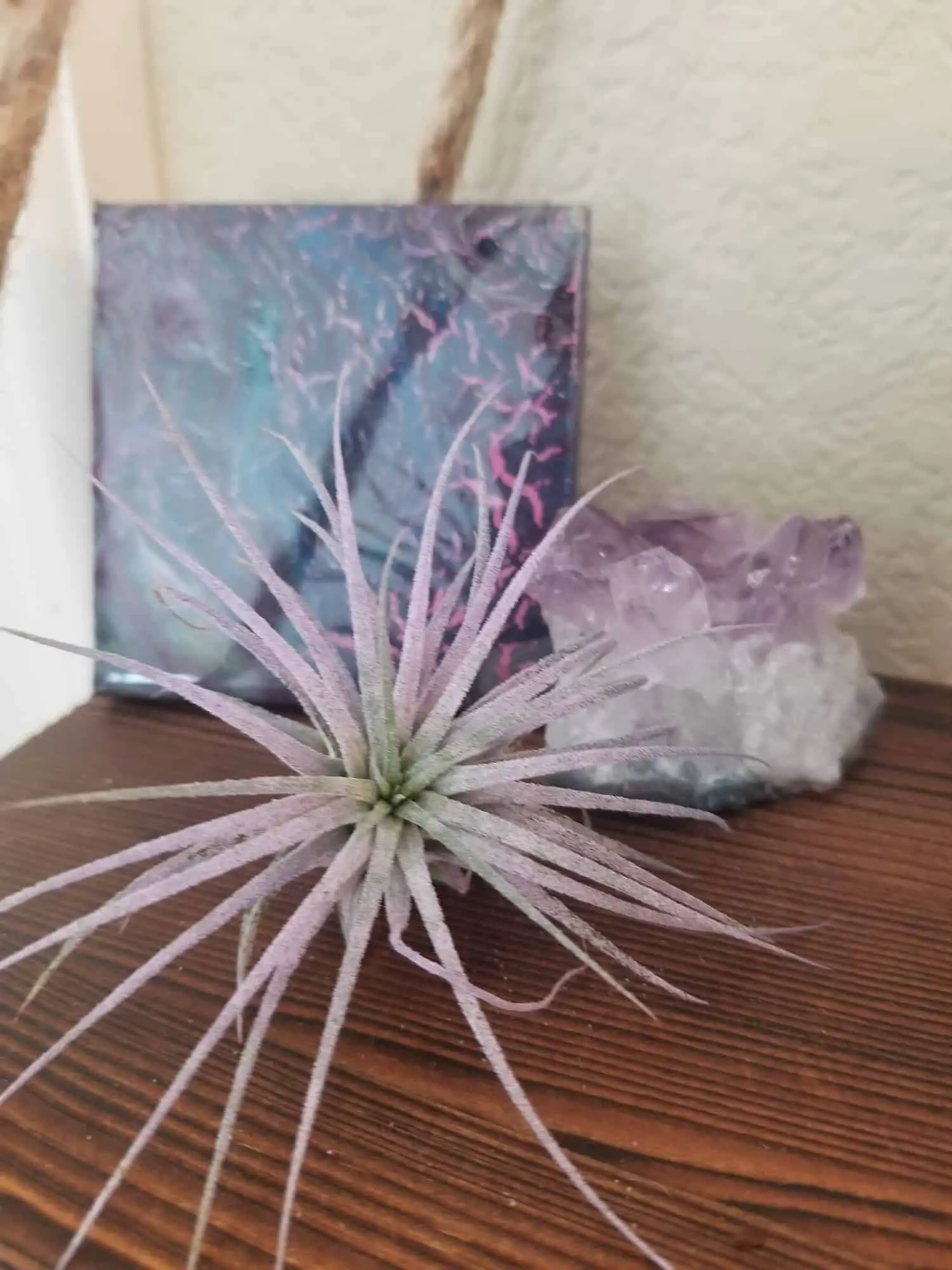
You can also find purple ionanthas that are labeled as “purple enhanced” ionanthas. Enhanced means that the air plant was dyed or painted. Personally, I don’t mind purchasing a spray-painted air plant occasionally if it looks nice, but some people are adamantly against painted plants. Just keep in mind that a painted air plant may not live as long as an unpainted air plant. This is because paint reduces the plant’s ability to absorb nutrients from the air.
6. Guzmania lingulata (Scarlet Star)

Guzmania lingulata, which is commonly known as Scarlet Star, is a widely available plant that you can find at most gardening centers. The Latin word lingulata means “tongue-shaped.” The genus name is for Anastasio Guzman who was a Spanish pharmacist and naturalist in the late 1700s. This plant is native to the tropical rainforests of Central America, northern South America, and the West Indies.
Guzmania lingulata can live in containers or be mounted on driftwood. There are many varieties of this plant available in orange, red, pink, and white.
Guzmania lingulata is on the British Royal Horticultural Society’s the Award of Garden Merit (AGM) list. The AGM is an annual award for garden plants. It was established by the British Royal Horticultural Society in 1922. This award should not be confused with the Award of Merit (AM) which is for “plants of great merit for exhibition” rather than for garden plants.
Like the Urn Plant, these plants have a reservoir or tank in the center of the plant. Keep this reservoir 1/4 to 1/3 of the way full if you keep your Guzmania lingulata indoors. You may want to keep the reservoir even emptier if your plant lives in a low-light environment.
These plants are susceptible to sac fungus Bipolaris sorokiniana (anamorph of Cochliobolus sativus) if the plant roots get too wet or cold. This fungs cause fatal root rot.
7. Neoregelia carcharodon ‘Tiger’
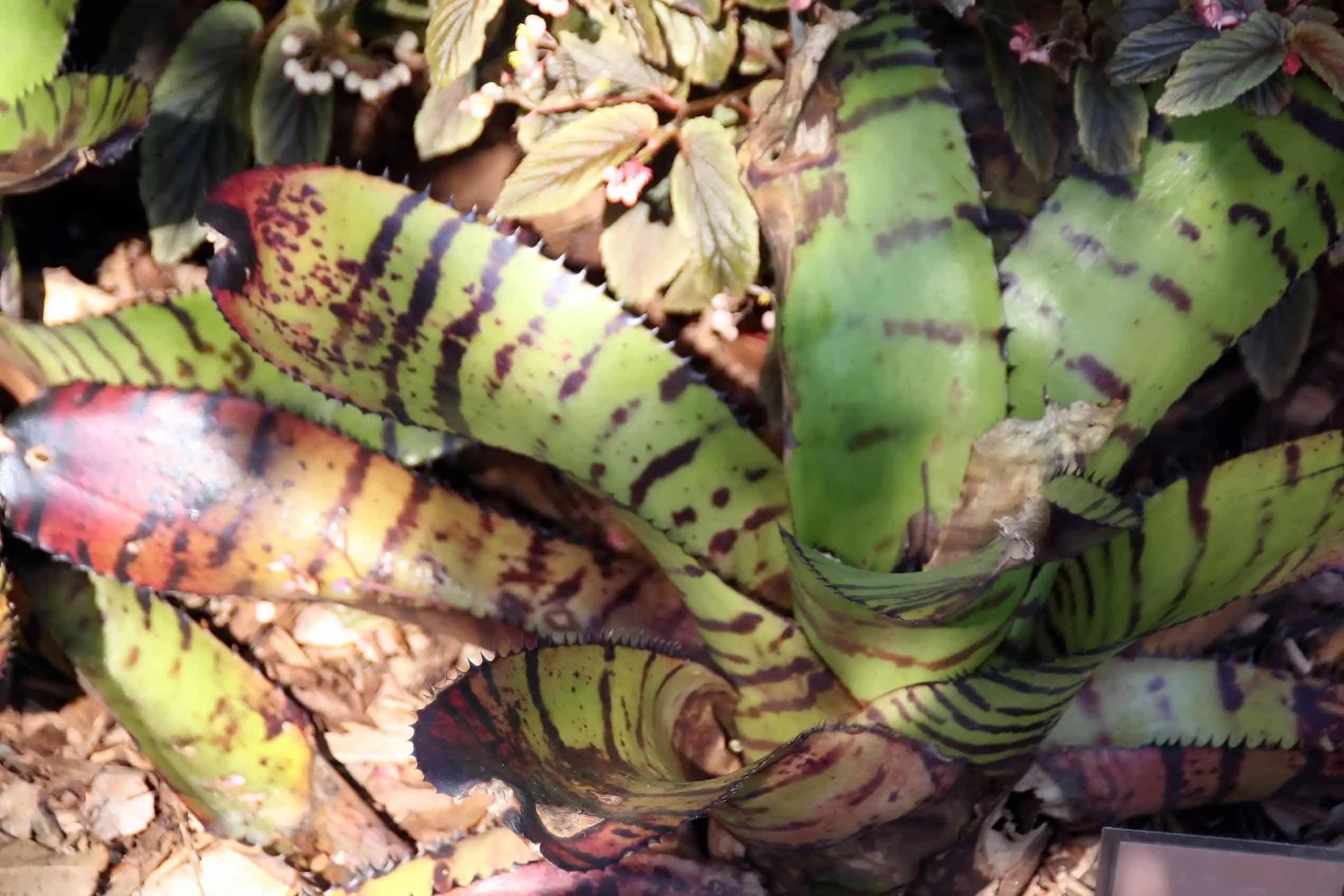
The Neoregelia carcharodon ‘Tiger’ is prized for the banded patterns on the leaves. It was introduced by Chester Skotak, who is a well known bromeliad hyridizer. Skotak has led several plant collecting expeditions throughout Central and South America and has introduced several bromeliad hybrids into the horticulture community.
The Neoregelia carcharodon ‘Tiger’ can grow to a width of almost 35 inches. Unlike some of the other bromeliads on this list, this plant can acclimate to full sun conditions. However, it will still do very well in partial shade.
The leaves of the plant do have spikes along the edges, so it is important to be careful when handling Neoregelia carcharodon ‘Tiger.’
8. Neoregelia carolinae (Blushing Bromeliad)
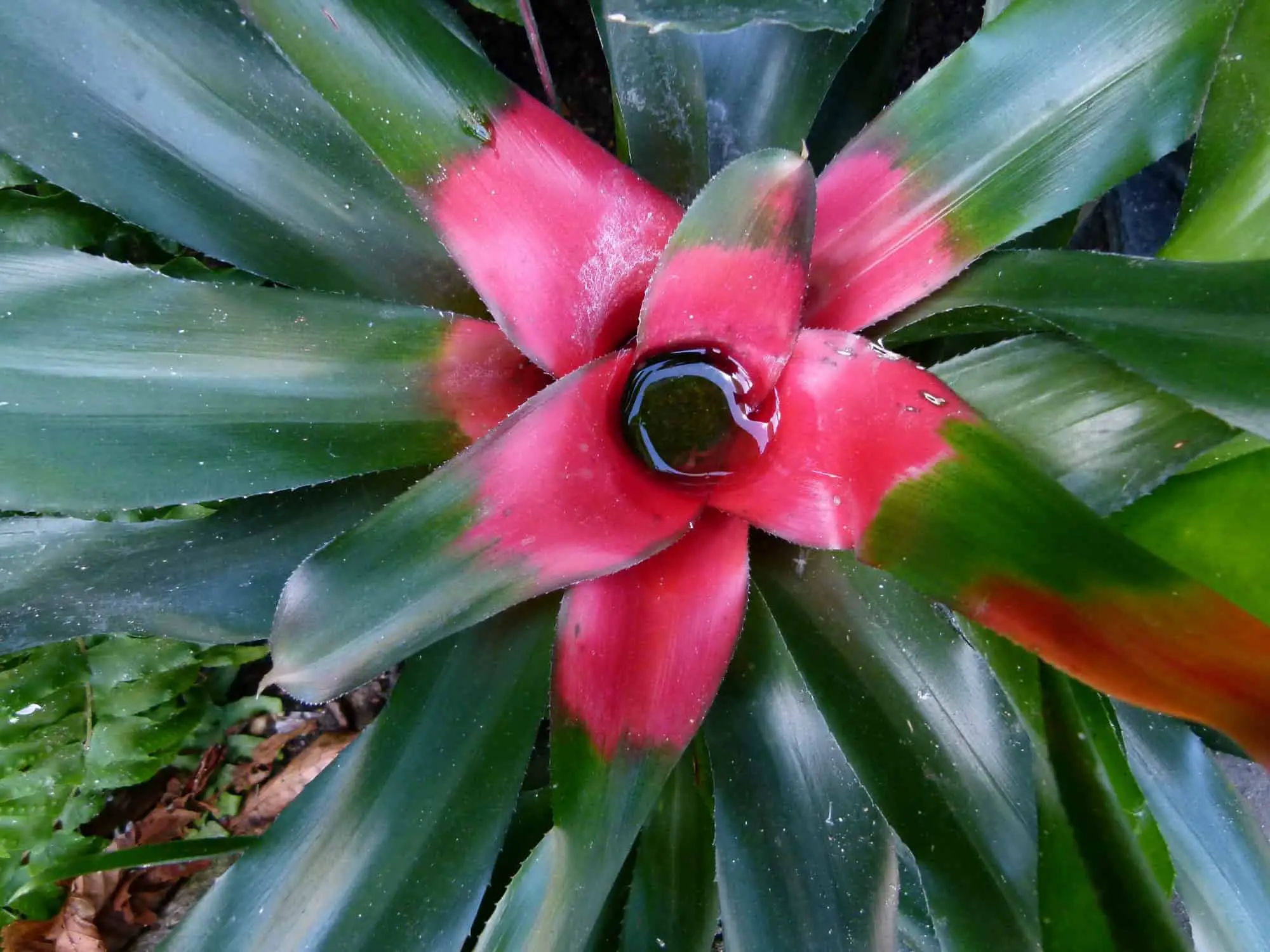
Neoregelia carolinae, which is commonly known as the Blushing Bromeliad, is known for the center of the plant turning red when it is about to bloom. This species of bromeliad is native to Brazil. Once mature, they will produce a small cluster of lavender flowers in the middle of the plant.
After flowering, the mother plant will slowly start declining and eventually die. During this time, they will form small pups at the base of the plant. You can remove these pups when they are about 1/2 of the size of the mother plant. My Blushing Bromeliad produced five pups, so it is possible to grow several new plants from one plant.
These plants can take more sunlight than some of the other bromeliads on this list. Blushing Bromeliad likes almost full sunlight, but their leaves will burn if exposed to hot, mid-day sunlight during the summer months. They will actually remain more compact and exhibit more intensely bright colors if exposed to more sunlight.
Like Guzmania lingulata, Neoregelia carolinae is on the British Royal Horticultural Society’s the Award of Garden Merit (AGM) list.
Like other plants on this list, Neoregelia caroline has a reservoir or tank in the center of the plant. Keep this reservoir 1/4 to 1/3 of the way full if you keep your bromeliad indoors. I recommend emptying out this reservoir frequently because the standing water can cause rotting and/or rot after a while.
9. Neoregelia caroline ‘Raphael’

This plant is a cultivar of the Neoregelia caroline. The difference between this plant and the Neoregilia caroline is the white stripes. These white strips are an example of albo-marginated leaves.
10. Tillandsia xerographica

Tillandsia xerographica is often referred to as the King of the Air Plants due to its large size. These plants are stunningly beautiful and require very little care. Tillandsia xerographica is native to the Central American countries of Mexico, Guatemala, Honduras, and Salvador. In the wild, xerographica plants can be found growing the highest branches.
Xerographica plants can be characterized as “xeric” air plants, meaning that they are native to drier environments. These plants will do better if you spray/mist them rather than soaking them. After watering, allow your xerographica to dry upside down for several hours near a sunny window to prevent rotting.
Tillandsia xerographica takes a long time to grow. The smaller xerographica plants that you see in stores are typically between 4 and 5 years old. In the wild, it takes xerographica plants between 12 and 18 years to bloom. However, cultivated varieties are often smaller and will bloom within 6 to 8 years if fertilized correctly. These cultivated varieties of xerographica will begin to grow pups 5 to 12 months after blooming. You can expect most xerographica plants produce 1 to 3 pups.
